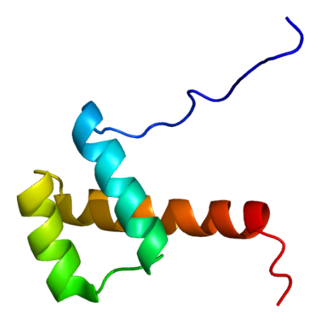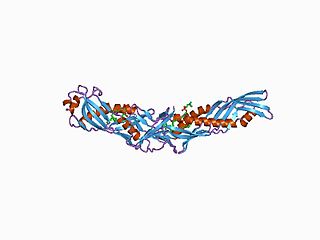
CD11c, also known as Integrin, alpha X (ITGAX), is a gene that encodes for CD11c.

Platelet factor 4 (PF4) is a small cytokine belonging to the CXC chemokine family that is also known as chemokine ligand 4 (CXCL4). This chemokine is released from alpha-granules of activated platelets during platelet aggregation, and promotes blood coagulation by moderating the effects of heparin-like molecules. Due to these roles, it is predicted to play a role in wound repair and inflammation. It is usually found in a complex with proteoglycan.

C-X-C motif chemokine ligand 10 (CXCL10) also known as Interferon gamma-induced protein 10 (IP-10) or small-inducible cytokine B10 is an 8.7 kDa protein that in humans is encoded by the CXCL10 gene. C-X-C motif chemokine 10 is a small cytokine belonging to the CXC chemokine family.

BPI fold containing family A, member 1 (BPIFA1), also known as Palate, lung, and nasal epithelium clone (PLUNC), is a protein that in humans is encoded by the BPIFA1 gene. It was also formerly known as "Secretory protein in upper respiratory tracts" (SPURT). The BPIFA1 gene sequence predicts 4 transcripts ; 3 mRNA variants have been well characterized. The resulting BPIFA1 is a secreted protein, expressed at very high levels in mucosa of the airways and salivary glands; at high levels in oropharyneal epithelium, including tongue and tonsils; and at moderate levels many other tissue types and glands including pituitary, testis, lung, bladder, blood, prostate, pancreas, levels in the digestive tract and pancreas. The protein can be detected on the apical side of epithelial cells and in airway surface liquid, nasal mucus, and sputum.

CX3C motif chemokine receptor 1 (CX3CR1), also known as the fractalkine receptor or G-protein coupled receptor 13 (GPR13), is a transmembrane protein of the G protein-coupled receptor 1 (GPCR1) family and the only known member of the CX3C chemokine receptor subfamily.

Oxidized low-density lipoprotein receptor 1 also known as lectin-type oxidized LDL receptor 1 (LOX-1) is a protein that in humans is encoded by the OLR1 gene.

Angiopoietin-1 receptor also known as CD202B is a protein that in humans is encoded by the TEK gene. Also known as TIE2, it is an angiopoietin receptor.

G-protein coupled receptor 4 is a protein that in humans is encoded by the GPR4 gene.

Hematopoietically-expressed homeobox protein HHEX is a protein that in humans is encoded by the HHEX gene and also known as Proline Rich Homeodomain protein PRH.

Leukocyte immunoglobulin-like receptor subfamily B member 4 is a protein that in humans is encoded by the LILRB4 gene.

BPI fold-containing family B, member 2, (BPIFB2) also known as bactericidal/permeability-increasing protein-like 1, is a protein that in humans is encoded by the BPIFB2 gene.

In molecular biology, the lipid-binding serum glycoproteins family, also known as the BPI/LBP/Plunc family or LBP/BPI/CETP family represents a family which includes mammalian lipid-binding serum glycoproteins and/or proteins containing a structural motif known as the BPI fold. Members of this family include:

BPI fold containing family A, member 3 (BPIFA3) is a protein that in humans is encoded by the BPIFA3 gene. The gene is also known as SPLUNC3 and C20orf71 in humans and the orthologous gene in mice is 1700058C13Rik. There are multiple variants of the BPIFA3 projected to be a secreted protein. It is very highly expressed in testis with little or no expression in other tissues. The Human Protein Atlas project and Mouse ENCODE Consortium report RNA-Seq expression at RPKM levels of 29.1 for human testis and 69.4 for mouse, but 0 for all other tissues. Similarly, the Bgee consortium, using multiple techniques in addition to RNA-Seq, reports a relative Expression Score of 95.8 out of 100 for testis and 99.0 for sperm in humans; however low levels of BPIFA3 between 20 and 30 were seen for a variety of tissues such as muscle, glands, prostate, nervous system, and skin.

BPI fold-containing family B member 1 (BPIFB1) is a protein that in humans is encoded by the BPIFB1 gene. BPIFB1 is a secreted protein, expressed at very high levels in mucosa of the airways and salivary glands, and at moderate levels in the digestive tract and pancreas.

BPI fold containing family B, member 3 (BPIFB3) is a protein that in humans is encoded by the BPIFB3 gene. Two variants have been detected in humans.

BPI fold containing family B, member 5 is a non-human protein encoded by the Bpifb5 gene, also known as Lplunc5. The BPIFB5 protein and Bpifb5 gene have been characterized in mammals such as rodents and even-toed ungulates but are apparently lacking in primates and other vertebrates such as birds, reptiles, and amphibians. The protein in rodents is expressed at moderately high levels in mucosa of the airways and at moderate levels in salivary glands, esophagus, and gonads ; in even-toed ungulates expression is high in testis, moderate in brain and striated muscle, and low in kidney.

BPI fold containing family B, member 6 (BPIFB6), also known as bactericidal/permeability-increasing protein-like 3 (BPIL3), is a protein that in humans is encoded by the BPIFB6 gene, also known as BPIL3 and LPLUNC6. It is expressed at high levels in hypertrophic tonsils, at relatively moderate levels in oronasal epithelium including nasal mucosa, tongue, and salivary gland, as well as esophageal mucosa at lesser levels. Orthologs are present in many vertebrate species including mammals, birds, reptiles, and amphibians.

Vomeromodulin is a non-human protein also known as BPI fold containing family B, member 9 (BPIFB9) in the rat encoded by the Bpifb9/RYF3 gene, and as BPI fold containing family B, member 9A (BPIFB9A) encoded by the Bpifb9a gene in the mouse. This protein has been characterized in mammals such as rodents, carnivores, even-toed ungulates, insectivores, bats, lagomorphs, and shrews but is apparently absent in primates and other vertebrates such as birds, reptiles, and amphibians. Its function is associated with detection of chemical odorant pheromone molecules.

BPI fold containing family A, member 2 (BPIFA2), also known as Parotid Secretory Protein (PSP), is a protein that in humans is encoded by the BPIFA2 gene. The BPIFA2 gene sequence predicts multiple transcripts ; 2 mRNA variants have been well characterized. The resulting BPIFA2 is a secreted protein, expressed at very high levels in the parotid (salivary) gland; at high levels in oropharyngeal mucosa, including tongue; and at moderate levels many other tissue types and glands including mammary gland, testis, lung, bladder, blood, prostate, adrenal gland, kidney, and pancreas.

BPI fold containing family A, member 4 (BPIFA4) is a non-human protein encoded by the Bpifa4 gene in mammals such as monkey, cat, and cow but does not appear in rodents and humans. It is also known as Latherin in horse, encoded by the Lath/Bpifa4 gene but is somewhat divergent from the other species. Latherin/BPIFA4 is a secreted protein found in saliva and sweat.














